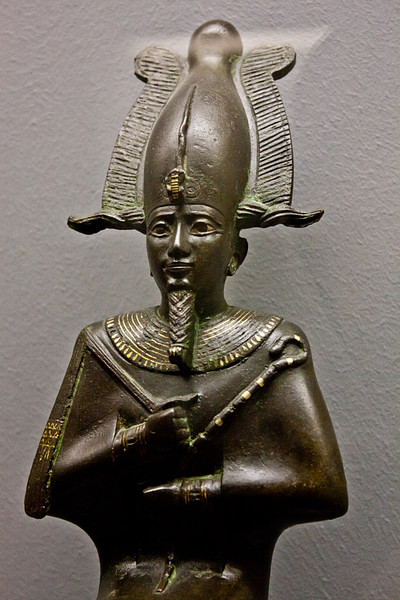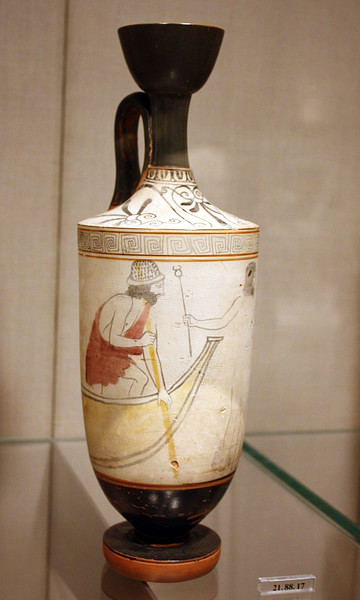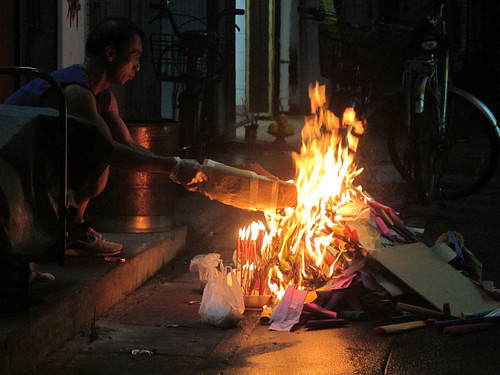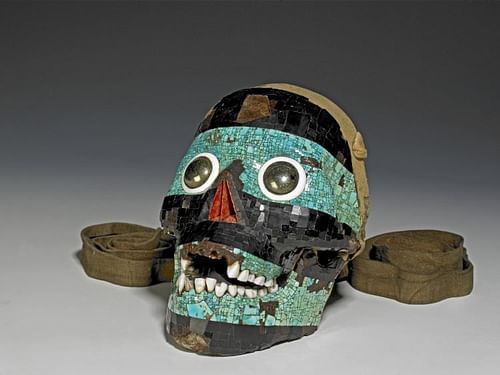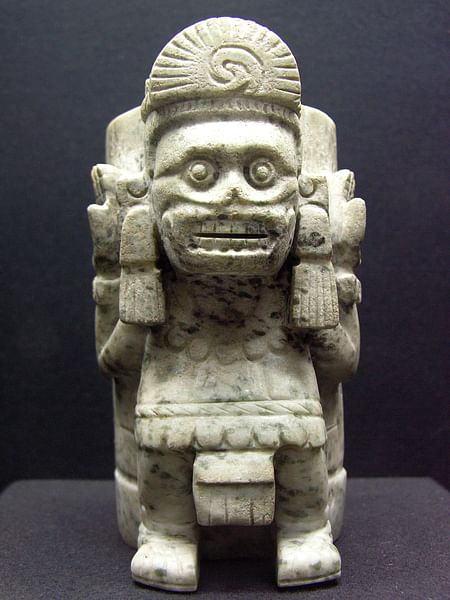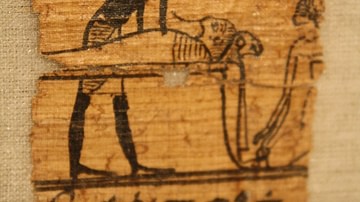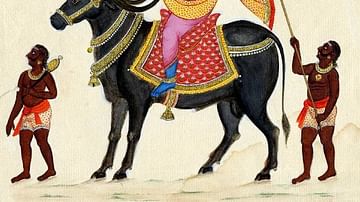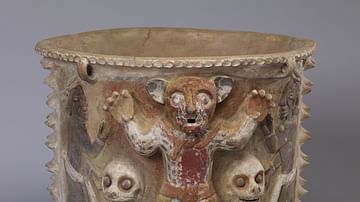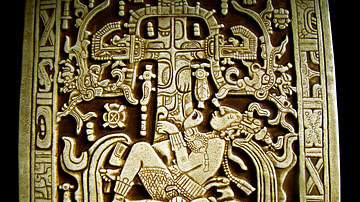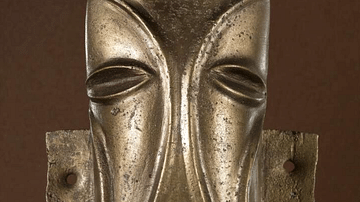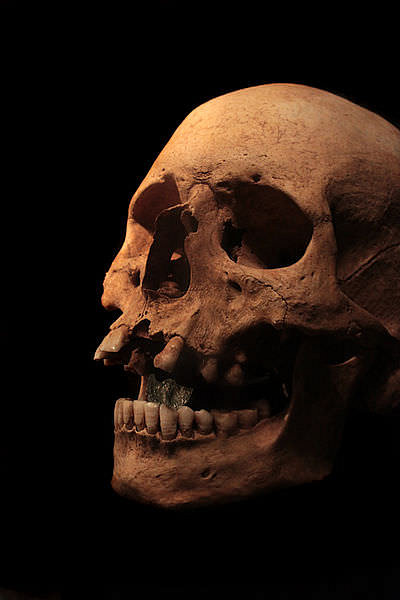
A belief in an afterlife was central to every major civilization of the ancient world and this encouraged the recognition of the reality of ghosts as the spirits of the departed who, for one reason or another, either returned from the realm of the dead or refused to leave the land of the living.
To the people of the ancient world, there was no doubt that the soul of a human being survived bodily death. Whatever an individual's personal views were on the subject, culturally they were brought up with the understanding that the dead lived on in another form that still required some kind of sustenance, in an afterlife that was largely dictated by several factors: the kind of life they had lived on earth, how their remains were disposed of at their death, and/or how they were remembered by the living.
The details of the afterlife in different cultures varied, but the constants were that such a realm existed, that it was governed by immutable laws, and that the souls of the dead would remain there unless given license by the gods to return to the land of the living for some specific reason. These reasons could include improper funeral rites, lack of any kind of burial, death by drowning where the body was not recovered, murder in which the body was never found (and so never properly buried), or to resolve some unfinished business or provide a true account of the events surrounding their death, such as when one was murdered and needed one's death avenged and the murderer brought to justice in order to rest in peace.
The appearance of ghosts of the departed, even those of loved ones, was rarely considered a welcome experience. The dead were supposed to remain in their own land and were not expected to cross back over to the world of the living. When such an event did occur, it was a sure sign that something was terribly wrong, and those who experienced a spiritual encounter were expected to take care of the problem in order for the ghost to return to its proper place.
This understanding was so prevalent that ghost stories can be found, with very similar themes, in the ancient cultures of Mesopotamia, Egypt, Greece, Rome, China, and India as well as regions of Mesoamerica and the Celtic lands of Ireland and Scotland. Ghosts are also depicted in the Bible in much the same way as they were in earlier Roman works. The following is by no means a comprehensive treatment of the subject. Many books have been written on the belief in ghosts in each of the cultures that are mentioned and the many that are not. The purpose of this article is merely to provide readers with the basic concepts of the afterlife and the belief in ghosts in the ancient world.
Ghosts In Mesopotamia
In Mesopotamian culture, death was the final act of life from which there was no return. The land of the dead was known by many names; among them was the Irkalla, the realm beneath the earth known as the "land of no return", where the souls of the dead dwelt in a dreary darkness, fed off dirt, and sipped from mud puddles (though there were other visions of the afterlife, such as that expressed in the work Gilgamesh, Enkidu and the Netherworld).
This existence was the final end for all the living, no matter how great or poor a life they had lived, and it was ruled over by the dark queen Ereshkigal. No soul was permitted to leave Irkalla for any reason, not even a goddess, as exemplified in the poem The Descent of Inanna, in which even the Queen of Heaven (and Ereshkigal's sister), Inanna, must find a substitute to take her place once she ascends back to the world of the living. Special dispensation, however, was given to souls who needed to complete some kind of mission. Ghosts could appear to people on earth if it was thought that they needed to right some kind of wrong.
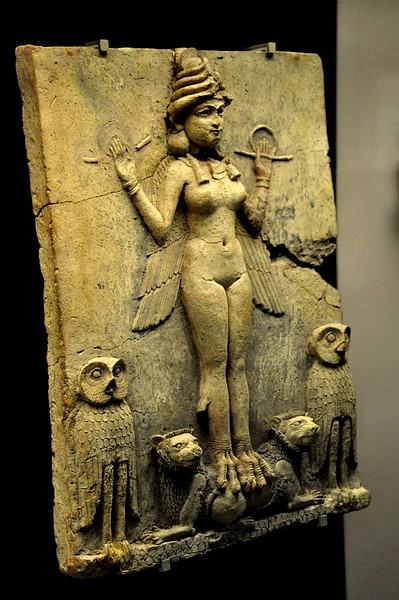
These appearances usually manifested themselves in some kind of sickness among the living. The scholar Robert D. Biggs writes:
The dead – especially dead relatives – might also trouble the living, particularly if family obligations to supply offerings to the dead were neglected. Especially likely to return to trouble the living were ghosts of persons who died unnatural deaths or who were not properly buried - for example, death by drowning or death on a battlefield. (4)
The doctors of Mesopotamia, known as the Asu and Asipu, employed spells that would placate the ghosts but, before such treatment could begin, the doctor would ask the patient to honestly confess any sins that could have called the ghost forth from the underworld. Sickness in Mesopotamia was considered an outward manifestation of some sin that was being punished either by the gods or by the spirits of the departed and was always assumed to be the fault of the one who was ill until it was proven otherwise.
Upon one's death, a spiritual entity known as a Gidim was created, which maintained the personal identity of the deceased and traveled on to the land of the dead. It was this Gidim that would return to haunt the living if proper attention had not been paid to funeral rites and burial or if there had been some unlawful act involved in the person's death. Inscriptions do make clear, however, that sometimes the Gidim could mischievously slip out of Irkalla for visits to the earth, where they would harass the living for no good reason.
These spirits would be punished by the sun god Shamash by having their funerary offerings taken from them and awarded to Gidim who had no one to remember them on earth, and so no one to provide them with offerings for their continued existence. Although there are records of loved ones returning from the afterlife with warnings or advice, most of the ghosts of Mesopotamia were unwelcome guests who were sent back to their realm through the use of charms, amulets, prayers, or exorcism.
Egyptian Ghosts
In ancient Egypt, the return of a ghost was also considered a very serious matter. For the Egyptians, non-existence was an intolerable concept, and it was believed that, at death, the soul traveled to the Hall of Truth where it was judged by Osiris and the Forty-Two Judges by having its heart weighed in balance with the white feather of truth; if the heart was found lighter than the feather, the soul proceeded on to the afterlife, while if it was heavier, it was thrown to the floor where it was eaten by the monster Amut and the soul would cease to exist.
One's heart would be lighter if one had lived a good life and heavier if one had not. The afterlife was known as the Field of Reeds, which was a mirror image of one's life on earth in Egypt. One would enjoy the house one knew, the stream by that house, one's favorite tree and dog, and so there was no reason for a soul to want to return to earth unless that soul had a very good reason for doing so.
In the earlier period of Egypt, the soul was considered a single entity known as the Khu, the immortal aspect of an individual but, in later times, the soul was thought to be comprised of nine different components. Two of these components, the Ba and Ka (spirit and personality), came together after death in the form of the Akh, and it was this entity that would return as a ghost. If proper rites had not been observed in burial, or some sin had been committed by the living either before or after the person's death, the Akh was given dispensation by the gods to return to earth to redress the wrong.
The living who were harassed by the ghost would have to plead their case directly to the returned spirit in hopes of a reasonable response and, if that was ineffective, would need to have a priest intervene and judge between the living and the dead. An example of this would be how, when misfortune fell upon a widower, it was first attributed to some "sin" he had hidden from his wife that she, now all-knowing in the Field of Reeds, was punishing him for. In a letter from a widower to his dead wife found in a tomb from the New Kingdom, the man pleads with the spirit of his wife to leave him alone as he is innocent of any wrong-doing:
What wicked thing have I done to thee that I should have come to this evil pass? What have I done to thee? But what thou hast done to me is to have laid hands on me although I had nothing wicked to thee. From the time I lived with thee as thy husband down to today, what have I done to thee that I need hide? When thou didst sicken of the illness which thou hadst, I caused a master-physician to be fetched…I spent eight months without eating and drinking like a man. I wept exceedingly together with my household in front of my street-quarter. I gave linen clothes to wrap thee and left no benefit undone that had to be performed for thee. And now, behold, I have spent three years alone without entering into a house, though it is not right that one like me should have to do it. This have I done for thy sake. But, behold, thou dost not know good from bad. (Nardo, 32)
If properly buried with adequate rites and continually remembered, the spirits of the dead could be of great benefit to the living and watch over them throughout their lives. There was a significant difference, however, in Egyptian understanding of a "spirit" who resided peacefully in the Field of Reeds and a "ghost" who returned to earth.
Ghosts in Greece & Rome
In ancient Greece, the afterlife consisted of three distinct realms. When one died, a coin would be placed in one's mouth to pay Charon the Ferryman to take the soul across the river Styx. This coin wasn't "payment" exactly as much as a sign of respect between the soul and the gods - the greater the value of the coin, the better seat the soul got in Charon's boat.
Once the soul was on the other side, one would pass by the three-headed dog Cerberus and then stand before the three judges to give an account of the life one had lived. When the story had been told, and as the judges conferred, one would be given a cup of water from the River Lethe, the waters of forgetfulness, and would forget one's former life on earth.
The judges would then assign the soul a location: if you had been a warrior who died in battle, you went to the Elysian Fields which were a paradise; if you had been a good person, you went to the Plain of Asphodel, also pleasant; if you had been a bad person, then you went to the darkness of Tartarus where the soul remained until it had atoned for the sins of one's life. No soul was "condemned to eternal damnation". The soul in Tartarus could become elevated to the Plain of Asphodel in time. As in the cultures of Mesopotamia and Egypt, souls were not expected to return to earth for any reason, but sometimes they still did. This same basic paradigm was adopted by the Roman culture who held a much more deep-seated belief in ghosts than the Greeks.
In the comedy Mostellaria (The Haunted House), the Roman playwright Plautus tells the story of how a rich Athenian merchant named Theopropides goes away on business and leaves the operation of his home to his son, Philolaches. Philolaches sees his father's absence as an opportunity to enjoy life to the fullest instead of proving himself a responsible steward and borrows a large sum of money to buy the freedom of a slave girl he loves. He then spends even more money to throw a grand party for his friends at his father's home.
All is going well for Philolaches until his slave, Tranio, tells him he has just gotten word that Theopropides is returning unexpectedly from his trip and will soon be home. Philolaches panics, not knowing what to do with his guests or how he will explain his enormous expenses, but Tranio assures him all will be well. He locks Philolaches and his guests in the house and meets Theopropides outside, telling him that he cannot enter because the house has been found to be haunted. He tells Theopropides that a ghost appeared to Philolaches in a dream, in the dead of night, while the torches were still lit, and informed him that he was murdered in the house long ago by a his villainous host who killed him for his gold. Tranio further says that the corpse of the murdered man is still hidden in the house, and it is dangerous for anyone to enter.
Theopropides believes the story without question and despairs of where he will live now. A money-lender then shows up, demanding payment on the loan Philolaches took out to buy the slave girl, and Tranio explains that this was done to buy the house next door since Theopropides' old home is now uninhabitable. Even when Theopropides goes next door and talks to Simo, the owner of the house, who denies that he sold it to Philolaches, Theopropides still shows no sign of doubting the ghost story.
Ghosts in ancient Rome were understood to appear in certain predictable ways and, usually, at certain times of the night. The historian D. Felton has noted that audiences who enjoyed Mostellaria would have found Tranio's haphazard ghost story hilarious because it departed from what people knew the truth of such a haunting would be: the ghost of the murdered man would appear in a room lit by a torch (since ghosts could not be seen without some kind of light) but would not appear in a dream unless he was a friend or loved one.
Ghosts who appeared in dreams were considered a completely different kind of spirit than a "restless" ghost who had suffered an untimely or unjust death and had not been buried with the proper rites. In his haste to put together a story for the master of the house, Tranio confuses two separate types of ghost story and, Felton observes, the ancient audience would have found this confusion funny.
An interesting departure from this paradigm is the story of the maiden Philinnion as told by Phlegon of Tralles (2nd century CE) and later by Proclus (5th century CE), in which Philinnion is married to one of Alexander the Great's generals, Craterus, and dies after six months of marriage. She is returned to life and visits a youth named Machates every night in his room at her parent's house. When she is discovered by her parents, she explains she was released from the underworld for a specific purpose and then dies a second time.
The historian Kelly E. Shannon, among others, has pointed out the lengths Phlegon goes to authenticate his story, presenting it as a first person account in the form of a letter relating an historical event which happened in a specific place (Amphipolis) at a certain time (during the reign of Philip II of Macedon) while being careful not to be so specific that a reader acquainted with the history of that place and time would have reason to doubt it. Shannon writes:
What can a reader reasonably be expected to believe? Roman literature is filled with strange and inexplicable creatures, objects, and occurrences, from centaurs to ghostly apparitions to volcanic eruptions. And these are not confined to the world of myth. Accounts of the natural world often focus on phenomena that may seem outlandish or impossible: authors like Pliny the Elder present as true things that a rational modern audience would find it difficult or even impossible to take seriously. (1)
This phenomena Shannon references were known to the Romans as mirabilia (wonders or miracles) and included talking beasts, incredibly tall spirit-women, visions from gods, and ghosts. Among the most famous of such mirabilia is the tale by Pliny the Younger (61-115 CE) who tells the story of the philosopher Athenodorus who comes to Athens and hears of a haunted house that is going cheaply because everyone is afraid of the ghost who haunts it. Athenodorus rents the house and, that night, hears the rattling of chains and wakes to find a man in his room who motions that he should rise and come with him. Athenodorus follows the ghost to a spot in the courtyard of the house where the spirit suddenly vanishes.
The next day Athenodorus has the city magistrate dig up the spot where they find the remains of a man entwined with chains. The body is buried with all the proper rites, and the house is no longer haunted. This story is typical of a "haunting" in which a spirit appears to seek redress for a wrong. The improper burial of the dead - or lack of any grave - was considered the prime reason for the return of a spirit from the afterlife even above a spirit's desire to have their death avenged.
The possibility of a spirit returning to ask a loved one to avenge his or her death is illustrated in a tale told by Apuleius, in which a man named Thrasyllus falls in love with the wife of his friend Tlepolemus and murders him while out hunting. Tlepolemus's spirit appears to his wife in a dream, tells her how he died, and asks her to avenge him. Thrasyllus has asked if he may court her, but she has denied his suit because she is still in mourning. She now says, however, that he may visit her that night. She offers him wine which is drugged and, once he falls into a stupor, she blinds him with her hair pin, claiming that death is too easy a punishment for what he has done, and he must now wander through life without seeing the world. She then runs to her husband's tomb, tells the story of his death, and kills herself with his sword. Thrasyllus has himself shut up in Tlepolemus' tomb and starves himself to death.
These, then, were the two main ways an ancient audience understood ghosts to manifest themselves (though they were not the only modes of manifestation), either in dreams or in physical appearances and usually having to do with some problem surrounding their death, and this same paradigm is observed in other cultures.
Ghosts in China & India
In Chinese culture the spirit of a person who had drowned, died alone, died in battle, or suffered some other death where they went unburied would appear bodily and could only be seen at night by torch light. The spirit of an ancestor who wished to relate some information or give a warning would appear in a dream.
Ghosts were considered a reality by the Chinese philosopher Mo Ti (l. 470-391 BCE) who argued in favor of accepting the report of the ghost of the minister Tu Po returning from the afterlife and assassinating Xuan, the king of Zhou. He reasoned that when people tell of how a certain machine operates with which one is not acquainted, or how certain people behave or speak in a land they have never been to, one should accept what they say if their report seems credible and if they, themselves, seem reliable witnesses.
Following this line of reasoning, then, one should accept what is said about ghosts if those who tell one about them can be trusted in what they have said about other things in life one can verify oneself. As ancient historical accounts, as well as contemporary reports of his time, contained references to ghosts, they should be accepted as a reality in the same way one recognized established history and news reports of the day, even if one has not experienced a ghost oneself.
The Chinese belief in ghosts was heavily influenced by their practice of ancestor worship and the belief that the departed continued to exert a powerful influence on people's lives. As in the other cultures mentioned, the spirits of the dead could benefit the living unless there had been impropriety in burial or funeral rites or the dead had been given dispensation from heaven to return to right a wrong.
The Ghost Festival, which originated to honor and appease the dead, continues to be held on the fifteenth day of the seventh month of the year. Known as the "Ghost Month", this time is thought to be when the veil between the realm of the living and that of the dead is thinnest and the dead can easily cross over (similar to the Celtic concept of Samhain and the Mesoamerican festival known as The Day of the Dead). During the Ghost Festival, people leave out food and gifts for the dead to appease and honor them in the hope that they will remain in their own realm and not trouble the living.
The Chinese afterlife was thought of as a journey in which the soul had to cross a bridge over an abyss where it was judged. If the soul was found worthy, it continued on, paused at a pavilion to look back on the land of the living one last time, and then drank a cup of a brew called Mengpo Soup which caused one to forget one's former life entirely. The ghost culture of China diverges at this point on what happens to the soul next; according to some works, the soul goes on to heaven, while according to others, it is reincarnated. If the soul is found unworthy as it crosses the bridge to the afterlife, it slips down into hell where it remains. In either case, the soul was not expected to return to the land of the living and, if one did, and it was not an ancestor appearing in a dream with some warning or advice, it was certain some kind of evil force was involved.
This is exemplified in the story of Ning Caicheng and Nie Xiaoqian from the writer Pu Songling's book of stories of 1680 CE. The story is thought to be much older than the 17th century CE and tells the story of Ning's visit to a temple where he is visited by the ghost of the maiden Nie. She tries to seduce him, but he resists owing to his belief in virtuous conduct. Two other travelers who come to stay at the temple are found dead the next morning with holes pierced in the soles of their feet and their blood drained.
Nie comes to respect Ning's virtue in resisting her advances and tells him that she died in the temple when she was only 18 years old and came under the control of a monster demon who inhabited the ground where she was buried. This monster required her to seduce travelers and drain their blood which she then fed to him. Ning digs up Nie's remains and carries them home with him where he re-buries them near his house and pours out a libation on her grave as a sign of respect and honor. Having performed the appropriate funerary rites for the girl, he turns to leave her grave, but she calls out to him, and he finds she has been returned to life due to his virtuous conduct and his efforts in burying her properly. Ning and Nie then marry and, as the story goes, live happily ever after with their children.
Chinese ghost stories often carry a moral along the lines of the Legend of Ning and Nie and emphasize virtuous behavior and kindness to others. Confucius himself believed in the efficacy of the ghost story because he felt the lessons learned from supernatural encounters could instill proper virtues in the living. He felt this was even true of encounters with so-called Hungry Ghosts, which were spirits whose relatives had forgotten their duties of respect and remembrance or spirits of those who had been murdered but whose killers had not been brought to justice. Hungry Ghosts were thought to have received special dispensation from the gods to torment the living until they received their due. The Hungry Ghost could torment the mind of the living or inhabit the home and behave along the lines of the familiar poltergeist.
This was also true in India where the ghosts of the departed were seen as a kind of Hungry Ghosts. In ancient (and modern) India ghosts were known as Bhoots and appeared as humans but with backward feet who could change their appearance without warning. The feet are thought to appear backwards to symbolize that something has gone wrong, that the spirit is in an unnatural state. Bhoots materialize when the person dies before their ordained time on earth. Since they were unable to enjoy the fullness of their lives, they return to earth in the hope of possessing the body of some living person.
Ghost possession, including the spirit re-animating their own corpse, was a great concern in ancient India, and some scholars maintain that this led to the practice of cremating the dead. If a body were cremated, the spirit could not return to re-animate it, and the burning of certain spices, along with the use of amulets and prayers, could protect the living from the spirit taking possession of them after it found it could not re-inhabit its dead body.
Since these spirits have died before their allotted time, they are very unhappy and usually angry. Ghosts were thought to cause multiple problems when they manifested themselves physically but, as in other cultures, were considered beneficial when they appeared in dreams and could be recognized as the spirit of someone the dreamer had known, especially a relative.
A particularly dangerous bhoot was known as the churail, which was the spirit of a woman who had died in childbirth. This ghost was thought to be encountered at crossroads and intersections and would make advances of friendship to the living. If the living person was a woman, the churail would seek to steal her children or try to possess her body and, if a man, it would seek to seduce and then kill him. Once the bhoot had lived out its allotted time on earth, even the churail, it would leave and re-enter the stream of reincarnation.
The Indian belief in an afterlife involving the transmigration of souls dictated that the soul of the deceased was judged according to its acts while in the body and would move either up or down a spiritual hierarchy in the next incarnation. It would seem, however, that not every soul moved on, since there are stories involving haunted regions, houses, and even cities where the ghosts have been present for many centuries.
The most famous of these sites is Bangarh Fort in Rajasthan which is an abandoned city thought to be inhabited by ghosts. The city was built under the Mughal Empire in 1573 CE and, as the legend goes, was prosperous until cursed by a reclusive hermit who lived nearby. In one version of the story, this hermit was a wise man who gave his blessing to the building of the city on the condition that none of the houses rose so high as to cast a shadow on his hillside home and so block his sun. The original builders of the city respected his request but, later, it was forgotten and additions were made to the palace which cast its shadow over the hermit's home. He cursed the city and its inhabitants for their lack of consideration and, in a single night, all the upper stories of the buildings were destroyed and the people who survived then deserted Bangarh Fort and built a new city of Bangarh nearby.
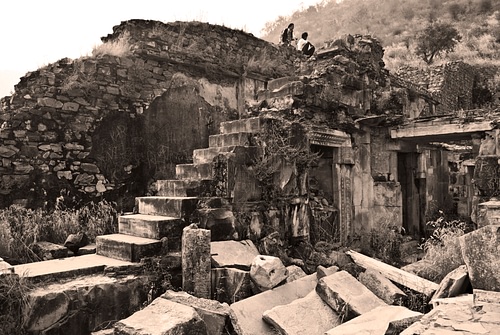
The other version of the story involves the beautiful princess Ratnavi and the evil wizard Baba Balnath. The wizard was in love with the princess but knew she would never return his feelings. He concocted a love potion that would powerfully attract the princess to him and disguised it as perfume, which he then had presented to her one day in the market. Ratnavi suspected the bottle held something other than perfume and poured it onto a nearby boulder which, because of the potion's magical powers, drew the boulder directly toward the wizard and crushed him.
As he was dying, Baba Balnath cursed Ratnavi and the entire city and swore no one should ever live within its walls again. As in the other version of the story, the city was then deserted in a single night after some catastrophe and, true to his curse, it was never again inhabited by the living. The dead, however, are believed to still reside at Bangarh Fort and there are reports in the present day by people claiming to hear spectral voices, disembodied laughter by the old bathing pool, footsteps, who also say they have seen lights moving in the city and have even seen the spirit of Princess Ratnavi herself.
Mesoamerican Ghosts
In the Maya belief system, lingering ghosts such as those said to inhabit Bangarh were intolerable and needed to be kept at bay through charms and amulets or driven back to the underworld through the intercession of a Daykeeper (shaman). The Maya idea of the afterlife was similar to the Mesopotamian view that the underworld was a dark and terrible place, but the Maya took the vision even further: in the Maya underworld (known as Xibalba or Metnal) there were numerous Lords of the Dead who could trick the soul of the deceased as it sought its way toward paradise.
Once the soul descended into this underworld, it was on a journey from which there was no turning back. Ghosts, as with the other cultures mentioned, were not expected to return to the earthly realm. The spirit would leave the body and be conducted across a great expanse of water by a spirit dog who would then help the soul navigate through the various trips and traps of the Lords of Xibalba to reach the Tree of Life which the soul then had to climb up to paradise.
Spirits who returned, therefore, were considered unnatural unless, as with other cultures, they appeared in dreams and were recognizable as friends or family members (though even this was not always the case). The Maya preferred to believe that the dead who were not at perfect rest could return in the form of plants that were either beneficial or should be avoided.
The best example of this belief is the Legend of the Xtabay which tells the story of two beautiful women, Xkeban and Utz-Colel. Xkeban was treated poorly by the respectable people of the town because she had engaged in unlawful sex with a man outside of marriage, but she was loved by the lower classes because of her goodness of heart and her kindness to all. Utz-Colel was highly regarded by the upper classes because she came from a good family and observed all the social etiquette, but she was hard-hearted and cruel and cared for no one but herself.
One day, a strange and intoxicating fragrance filled the village and, when the poor people followed it to its source, they came to Xkeban's hut and found her dead inside from some unknown cause. The lovely fragrance was emanating from her body. They buried her and, the next day, found beautiful wildflowers growing all over her grave which carried the same scent they had experienced the day before.
Shortly after this, Utz-Colel died but, from her body rose a terrible odor. The respectable people of the village buried her with great ceremony as a good and noble woman and planted many flowers but, the next day, the flowers had drooped and died. From her grave then grew the flower known as Tzacam which has no scent while, from Xkeban's grave, grew the Xtabentun flower which smells sweet, and the two women's souls became infused with their respective flowers.
When Utz-Colel found that she was a prickly flower without scent, she was jealous of Xkeban and believed that Xkeban's sin of physical love had somehow brought her such prosperity. She entered into league with the dark spirits of Xibalba to bring her back to life so that she could now have sex with whomever she pleased and be as blessed as Xkeban. Utz-Colel did not understand, however, that Xkeban's act had been motivated by love while Utz-Colel's was motivated by ambition. She was returned to earth as the Xtabay, the flower which grows from the Tzacam cactus but sometimes assumes a human form and waits for travelers at crossroads. If a man pays attention to her, she seduces and then kills him while, if the traveler is a woman, she punishes her by afflicting her peace of mind.
The Aztecs have a similar entity in their beliefs which is actually closer to the churails of India. The Aztec spirit is known as a Cihuateteo and is the ghost of a woman who died in childbirth. These spirits also haunted crossroads but ignored male travelers; they waited for women with children and then struck the women down and stole their children. They were also thought to be able to slip into homes in the night to abduct children there.
Amulets and charms were hung by doorways and windows to ward off the cihuateteo. In the Aztec belief system, ghosts were also unwelcome guests who only brought bad news or served as omens of doom. Like the Maya, the Aztecs held that the afterlife was a gloomy place of no return and so, when a spirit did come back, it was a clear indication that something had gone wrong or soon would.
As with the Maya and the Tarascans, the Aztecs believed that dogs could see and would protect one against ghosts, and so buried their dead with dogs who were thought to then serve the soul in the afterlife as both a guide through the underworld and as a protector against ghosts. The Tarascans were deeply troubled by the fear of ghosts and so developed the concept of the spirit dog.
It was thought that ghosts were the spirits of those who had been improperly buried, who had died alone on a hunt and were never found, or who had drowned. These spirits would return to haunt the living until their bodies were found and properly buried with ceremonies. The problem, of course, was that the bodies could not be found. In these cases, the Tarascans held that a spirit dog would find the body and lead the soul away to the afterlife so that it would not trouble the living.
The dead were celebrated in Mesoamerican cultures instead of being mourned and this gave rise to the event known today as The Day of the Dead (El Dia de los Muertos). The community gathers on this day to remember those who have passed on to the other side and to celebrate their lives. Originally, the Aztecs honored the goddess of the underworld, Mictecacihuatl, during this festival, and then honored the souls of children who had died, and then adults who had passed on to the other side. The festival used to take place during the time of the corn harvest (late July through August) but after the Spanish conquest it shifted to November to coincide with All Saints Day of the Catholic church.
Celtic Ghosts
This shift in the season of the Day of the Dead in Mesoamerica came about because of the Catholic church's policy of "Christianizing" previously existing pagan festivals. A similar celebration observed in northern Europe in Ireland, Scotland, and Wales is known as Samhain (pronounced sou-when or sow-when). The pagans of these regions saw life as cyclical, not linear, and the year revolved like a wheel. Samhain was the end of one cycle and the beginning of the next and it was thought that, at this time, the veil between the living and the dead grew thin and the dead could walk again in life.
This took place in late October/early November and traditionally is considered to begin at sundown on 31 October and go until 2 November (though some have observed the celebration for a week before the 31st of October to a week after). Although many modern day sources on the internet and some popular television shows from the United States claim that Samhain was the Celtic god of the dead and that people would sacrifice to him on 31 October, this is not so. There never was a Celtic god of the dead known as Sam Hain. "Samhain" simply means "summer's end" in the Celtic language.
The dead were thought to walk freely through the world during this time and people would prepare meals which their departed friends and relatives enjoyed while alive. Samhain was an important celebration when the harvest was brought in, cattle were slaughtered and salted for the winter, and the bones were burned, a practice which gave rise to the bone fires, which today are known as bonfires.
The darker side of Samhain, however, was that the dead who were restless (like the Hungry Ghosts of China) were also free to roam, and so people initiated the practice of wearing masks so they would not be recognized by a spirit who may wish one harm. This custom eventually evolved into the modern-day celebration of Halloween.
The Roman Empire had conquered much of the region of the Celts by the 1st century CE and, when Christianity became the official religion of the empire in the 4th century CE, the church incorporated many pagan holidays into their calendar. Since Samhain was such a popular festival, it was brought into the church as Allhallows or Hallowmas, which became All Soul's Day and then All Saint's Day when believers prayed for the souls of the dead in purgatory. As with Samhain in Europe, so it was with the Day of the Dead in Mexico; the pagan festivals became days of Christian observances.
Conclusion
Although the belief that the dead could return to earth at All Soul's Day persisted, it changed as the Christian vision of the afterlife became increasingly popular and ghosts came to be linked with demons and the devil. Ghosts are mentioned in the Bible in passages such as Matthew 14:25-27, Mark 6:48-50, and Luke 24:37:39. Among the most famous passages concerning a ghost is the one from I Samuel 28: 7-20 in which King Saul goes to the Witch of Endor and asks her to conjure the ghost of Samuel, his former advisor and a prophet of God. Saul is afterwards cut off from God's favor for choosing to consult a spirit about what he should do instead of trusting in God for his future.
Ghosts, and especially conjuring spirits, came to be seen in a negative light as Christianity gained more adherents. The passage in Mark 6 has also been interpreted as a negative representation of ghosts in that the disciples think that Jesus is a ghost when they see him walking on the water. Ghosts could not walk on water, only gods and those who were divine, and so when the disciples mistake Jesus for a ghost, it is thought to show their hardness of heart in receiving Jesus' message of salvation. The scholar Jason Robert Combs has noted how the writer of Mark knew that his audience would recognize the symbolism of the ghost. He writes:
Gods and divine men walk on water; ghosts do not. But when the disciples see Jesus walking on water, they believe the impossible rather than the obvious. Mark's insertion of this absurdity, "because they saw him walking on the sea they thought he was a ghost" (6:49), emphasizes in dramatic fashion the disciples' misconstrual of Jesus' messiahship. (358)
The author of Mark continually makes the point that the disciples failed to grasp who Jesus was and what his mission was about. His use of the ghost early in his book would have made this point clearly to an ancient audience who would have recognized that a ghost cannot walk on water and that, further, water was often employed to ward off ghosts. The biblical book of I John 4:1 states that one should test all spirits to see if they are from God and not believe that every spirit is what they appear to be. This passage, coupled with the belief expressed in the passage from Mark and I Samuel and others, encouraged an even further negative view of ghosts than people had previously.
Although ghosts had always been regarded as unwelcome and unnatural, they were now linked with the demonic and were seen as agents of the devil. People were encouraged to reject the reality of ghosts since, at death, the soul of the person went to either heaven, hell, or purgatory and did not return to earth. If one saw a ghost, then, one should assume it was a trick of the devil to snare one's soul for hell in causing them to doubt the divine order of God.
This attitude toward ghosts is exploited for dramatic purposes in Shakespeare's Hamlet, when Prince Hamlet doubts that the ghost he has seen is actually his father returned from the dead and says, "The spirit that I have seen/May be a devil, and the devil hath power/To assume a pleasing shape, yea, and perhaps/Out of my weakness and my melancholy/As he is very potent with such spirits/Abuses me to damn me" (II.ii.610-615). This view of ghosts completely altered the old understanding that ghosts were the souls of those who had died and, since they were of the devil, belief in them was discouraged.
In time, a growing trust in a secular and more "scientific" way of viewing the world completed the work begun by the church and relegated ghosts to the realm of superstition and fiction. Judging from the number of websites and books devoted to the subject, there are many in the modern day who are interested in the subject of ghosts but, generally speaking, the belief is not encouraged culturally; precisely the reverse situation of how ghosts were viewed in the ancient world.
The journalist John Keel, who investigated many so-called paranormal events and is best known for his book The Mothman Prophecies, once wrote that there is no such thing as the "paranormal" or "supernatural". After citing a number of strange events which people have experienced throughout history, Keel observed that what people in the modern day call "paranormal" or "supernatural" events are actually normal and natural aspects of life on earth.
The world of spirits, ghosts, and souls appearing from an afterlife, according to Keel, may be just as much of a reality today as it was to the people of the ancient world; the reason people no longer accept ghosts as a part of life is simply because a world that operates that way is no longer recognized as valid. A new paradigm of how the world worked rose with Christianity, and then the acceptance of a secular view of the universe, and ghosts were further distanced from the realm of the living until, finally, they lost their actual potency and became the staple of tales and legends.
